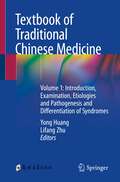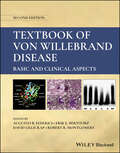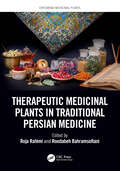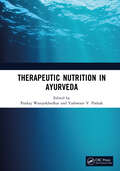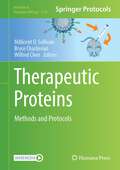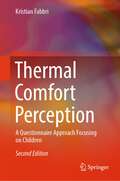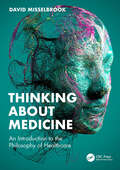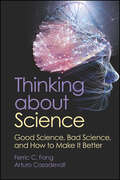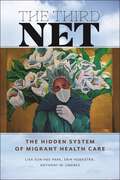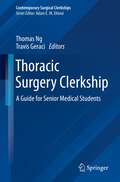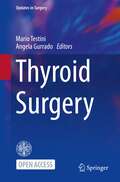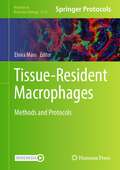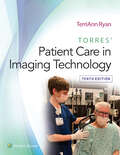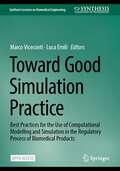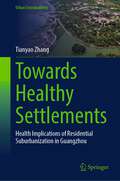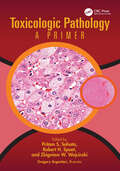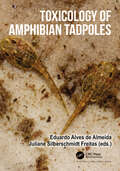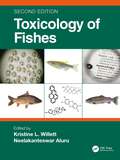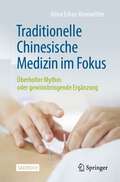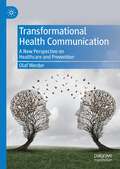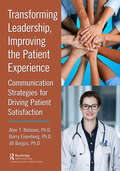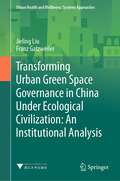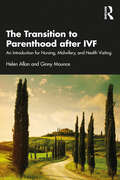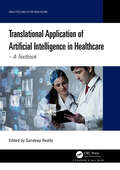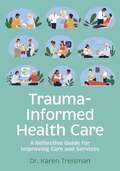- Table View
- List View
Textbook of Traditional Chinese Medicine: Volume 1: Introduction, Examination, Etiologies and Pathogenesis and Differentiation of Syndromes
by Yong Huang Lifang ZhuThis book covers all the contents from theoretical basis to clinical practice comprehensively, which are under the guideline of classic inheritance and the essence of TCM. TCM is a comprehensive discipline. In this book, philosophical foundation, physiology and pathology, etiology, differentiation and diagnostics, and health-preservation of TCM, Chinese materia medica and prescription, acupuncture and moxibustion, characteristic therapies, and common clinical disease are systematically arranged.From Chapter 1-4, a clear picture of the philosophical foundation of TCM from yin-yang, five-element, qi, blood, body fluids and zang-fu viscera theory is presented. From Chapter 5-7 include etiology, pathogenesis, diagnostic and differentiation of syndromes. Chapter 8 is one of the most popular chapters with a topic of health-preservation. Chapter 9 mainly present clinical TCM therapies of common disease.This book is a useful textbook for graduate and undergraduate students inmedical schools, including MBBS (Bachelor of Medicine and Bachelor of Surgery) student.
Textbook of Von Willebrand Disease: Basic and Clinical Aspects
by Augusto B. Federici Erik E. Berntorp David Lillicrap Robert R. MontgomeryTEXTBOOK OF VON WILLEBRAND DISEASE Comprehensive resource summarizing recent research on von Willebrand disease, showing clinicians how to optimize management of patients with this disorder The newly revised and updated second edition of Textbook of von Willebrand Disease: Basic and Clinical Aspects, 2nd edition describes the important and complex role of von Willebrand factor (VWF) in hemostasis and thrombosis, covering not only the current understanding of its molecular biology, but also the association between genetic variants of VWF and different von Willebrand disease (VWD) phenotypes. The text also reviews the important area of the obstetric and gynecological manifestations of VWD, as well as how to manage patients with VWD for surgery. Many advances in agents are included in this updated edition, as well as the wide topics such as VWF in Angiogenesis, and VWF/ADAMTS13 as risk factors of thrombosis. Edited by a team of experts in VWD and an international team of contributors, Textbook of von Willebrand Disease covers sample topics such as: VWF structure and function, biosynthesis and organization of VWF, modulation of VWF by ADAMTS13 and assessment of VWF clearance Clinical, laboratory and molecular markers of different VWD types, from the mild forms of type 1 VWD and the moderate variants types 2A, 2B, 2M, 2N to the most severe type 3 VWD Pediatric aspects of VWD and of women with VWD Management of GI bleeds and appropriate therapies in surgery, and plasma-derived and recombinant VWF concentrates Acquired von Willebrand Syndrome, cardiovascular causes of AVWS, gastrointestinal bleeds in VWD and AVWS, and prophylaxis in von Willebrand disease Providing complete and accessible coverage of the subject, Textbook of von Willebrand Disease: Basic and Clinical Aspects, 2nd edition is a valuable resource for hematologists in practice and in training, along with specialists in thrombosis, hemostasis, and bleeding/clotting disorders.
Therapeutic Medicinal Plants in Traditional Persian Medicine (Exploring Medicinal Plants)
by Roja Rahimi Roodabeh BahramsoltaniTraditional Persian Medicine (TPM) is one of the oldest medical doctrines, globally known due to pioneering physicians and scientists. The greatest source of natural medicines in TPM originates from medicinal plants. Therapeutic Medicinal Plants in Traditional Persian Medicine provides a background on the history of TPM, as well as an introduction to 40 of the most popular medicinal plants used in TPM. It is a practical guide for readers interested in medicinal plants used in the prevention, management, and treatment of different diseases.Features: Includes both traditional therapeutic applications and modern evidence/ uses Makes a comparison between preclinical and clinical studies Provides information on major chemical constituents, therapeutic uses, adverse reactions, and safety for each plant species A volume in the “Exploring Medicinal Plants” series, this book is a valuable resource for researchers, students, academicians, and scientists dealing witth medicinal plants, as well as for those interested in the fields of pharmacognosy, naturopathy, phytotherapy, and traditional medicines.
Therapeutic Nutrition in Ayurveda
by Pankaj Wanjarkhedkar Yashwant V. PathakNutrition remains the key to the successful treatment of diseases, in addition to the various evolved medical treatments across the world. The treatment outcome improves to a better extent with a degree of nourishment of the patients. Therapeutic Nutrition in Ayurveda (TNA) categorizes diseases system-wise and discusses nutrition with references from Ayurveda classics as well as publications from indexed journals in today’s world. This book emerges as a pilot project to discuss the clinical experiences directly and the concept of nutravigilance by experienced authors of respective specialties like hepatology, neurology, dermatology, ophthalmology, oncology, cardiology, gynecology, and so on. It broadly discusses diet and nutrition based on 12 different groups of diet in Ayurveda. Nutrition has been widely discussed for every disease dynamically in Ayurveda, with details of exclusion and inclusion of foods over a stipulated period or entire duration of treatment. Key Features: Presents system-wise and disease-wise therapeutic nutrition Includes clinical experience of physicians on therapeutic nutrition Contains interdisciplinary discussion on therapeutic nutrition with an integrated approach The integration of traditional and conventional health systems, along with the multidisciplinary approach, is the emerging trend for inclusive health care in the coming decades. This book serves as a handy guide for health care professionals across the continents, providing interdisciplinary correlations on nutrition.
Therapeutic Proteins: Methods and Protocols (Methods in Molecular Biology #2720)
by Millicent O. Sullivan Bryce Chackerian Wilfred ChenThis volume covers the latest key aspects of therapeutic protein applications. Chapters in this book cover topics such as the discovery, production, and conjugation of protein-proteins with discussions on the direction of future development and advancements; ways to use these engineering proteins for therapeutic and vaccine applications; and the use of modified protein nanocarriers. Written in the highly successful Methods in Molecular Biology series format, chapters include introductions to their respective topics, lists of the necessary materials and reagents, step-by-step, readily reproducible laboratory protocols, and tips on troubleshooting and avoiding known pitfalls.Cutting-edge and practical, Therapeutic Proteins: Methods and Protocols is a valuable resource for any researcher who are interested in learning more about the field of therapeutic proteins.
Thermal Comfort Perception: A Questionnaire Approach Focusing on Children (Springerbriefs In Applied Sciences And Technology Ser.)
by Kristian FabbriThis book offers a comprehensive exploration of children's understanding and experiences of thermal comfort. The book provides a methodology for evaluating comfort that takes into account the unique perspectives of children. The first part of the book provides an overview of the history of thermal comfort, the human body and environmental parameters, and common thermal comfort indexes. It also offers guidelines for creating questionnaires that accurately assess children's perceptions of indoor thermal comfort. The book then delves into children's understanding of the concepts of comfort and energy, as well as the factors that influence their perception of these concepts. It addresses the psychological and pedagogical aspects of thermal comfort judgment, as well as the architectural and environmental characteristics that contribute to children's perceptions of comfort. First published as Indoor Thermal Comfort Perception, this updated edition also includes new sections on architecture and sensitivity, exploring the impact of classroom spaces on learning, and outdoor education and thermal comfort outdoors, based on qualitative research. These additions provide valuable insights for future studies on these topics. While physical parameter measurements and comfort indexes are useful in thermal comfort, the book emphasizes the importance of ergonomic assessments in the form of questionnaires, which offer unique insights into children's experiences. The book fills a critical gap in understanding children's perceptions of thermal comfort and is essential reading for HVAC engineers, architects, environmental psychologists, and researchers in the medical and cognitive fields.
Thinking About Medicine: An Introduction to the Philosophy of Healthcare
by David MisselbrookThis introduction to the philosophy of medicine surveys the landscape of western philosophy as it pertains to healthcare in an accessible way. Written by a doctor for doctors and other health professionals, framing the 'toolbox' of philosophy within the community of medicine, it encourages examination of the implicit assumptions made in the construction of medical knowledge and practice.Taking the reader step by step through the concepts that underpin modern philosophy, they will be challenged to reflect upon the premises within clinical practice which might benefit from scrutiny and challenge, including the nature of scientific knowledge, the limits of our biomedical model, the cultural and relational context, and the failure to recognise or manage adequately the fact/value distinction in medicine and healthcare.The book is an ideal textbook for students of medicine and medical philosophy and will also be of interest to bioethicists, medical sociologists, clinical commissioners and to practicing clinicians in medicine and the allied health professions seeking to improve their understanding of philosophy and ethics and sharpen their critical thinking skills.
Thinking about Science: Good Science, Bad Science, and How to Make It Better (ASM Books)
by Ferric C. Fang Arturo CasadevallThinking about Science: Good Science, Bad Science, and How to Make It Better A riveting exploration of the world of science, diving headfirst into its triumphs and tribulations. Penned by seasoned microbiologists Ferric C. Fang and Arturo Casadevall, this book offers a comprehensive analysis of the scientific enterprise through various lenses, including historical, philosophical, and personal. From their unique vantage points as researchers, clinicians, and educators, Fang and Casadevall dissect the intricate mechanisms of science, shedding light on its strengths and weaknesses. Through engaging historical anecdotes, personal narratives, and insightful academic studies, they present a candid evaluation of science�s performance, including a thought-provoking examination of its role during the COVID-19 pandemic. A must-read for anyone curious about the present predicaments and future potential of science, Thinking about Science: Good Science, Bad Science, and How to Make It Better is more than just a book; it�s a roadmap to understanding and improving the scientific endeavor for the benefit of society at large. �The authors have given us a thoughtful description of science and the joy of discovery, an unflinching diagnosis of where improvements are needed, and recommendations for remedies well worth considering. Scientists, science and society would benefit if this book were read by both future and established scientists, as well as the administrators, policymakers, and regulators who are in a position to help us do better.� �Michael Kalichman, UC San Diego �With a deep understanding of the profound impact of science on society, the authors provide thought-provoking perspectives on changes in the scientific enterprise that will support sustainable, equitable practices, and engender public trust. An engaging read for everyone with an interest in science or science policy. � �Stanley Maloy, San Diego State University
The Third Net: The Hidden System of Migrant Health Care (Health, Society, and Inequality #5)
by Lisa Sun-Hee Park Erin Hoekstra Anthony M. JimenezReveals the presence of an informal system of valuable support and care for marginalized migrantsThe United States’ health care system not only consists of a formal safety net, but also an informal and disjointed network of organizations that offer basic care to millions of migrants. This “Third Net” provides free or low-cost health care for the undocumented, low-income, and uninsured migrants who are excluded from the formal system. This groundbreaking study sheds light on the existence of the Third Net and its implications for the overall inequalities in the US health care system.The Third Net is made up of diverse providers with varying levels of service, organizational culture, and mission. These providers operate in unconventional settings, such as mobile clinics on wheels; pop-up clinics in repurposed spaces; and unlicensed, makeshift clinics run by health activists. Despite their unassuming appearances, these clinics are vital resources for marginalized populations that often go unnoticed by the general public, revealing the shortcomings of our formal health care system.By examining these alternative health care spaces, the authors expose the inequities entrenched in the broader health care system and urge a reevaluation of it entirely in order to address these injustices.
Thoracic Surgery Clerkship: A Guide for Senior Medical Students (Contemporary Surgical Clerkships)
by Thomas Ng Travis GeraciThis quick-reference guide is the first book written specifically for the many third- and fourth-year medical students rotating on the thoracic surgery service. The book focuses on the diagnosis and management of the most common pathologic entities. Each chapter covers history, physical examination, imaging, and common diagnoses. For each diagnosis, the book sets out the typical presentation, options for non-operative and operative management, and expected outcomes. Chapters include key illustrations, quick-reference charts, tables, diagrams, and bulleted lists. Students can read the text from cover to cover to gain a general foundation of knowledge that can be built upon when they begin their rotation, then use specific chapters to review a sub-specialty before starting a new rotation or seeing a patient with a sub-specialty attending. Topics covered include lung cancer, pulmonary resection, pleural empyema, thoracic outlet syndrome, esophageal disorders, tracheal malignancies, and much more.Practical and user-friendly, Thoracic Surgery Clerkship is the ideal, on-the-spot resource for medical students and practitioners seeking fast facts on diagnosis and management. Its bullet-pointed outline format makes it a perfect quick reference, and its content breadth covers the most commonly encountered problems in clinical practice.
Thyroid Surgery (Updates in Surgery)
by Mario Testini Angela GurradoThis open access book on thyroid surgery has been authored by an international team of contributors who present a comprehensive understanding of both benign and malignant thyroid disorders. It also outlines an interdisciplinary approach to their surgical management that reflects the latest changes in surgical techniques. The book reviews the most up-to-date literature available on thyroid surgery and presents it in a concise manner for use in clinical practice. For each thyroid disorder, the book covers etiology, clinical manifestations, diagnostic and localization procedures, as well as surgical and non-surgical treatment options. The operating techniques and postoperative management are explained in detail, while the benefits, risks, controversial issues, and cost-effectiveness of each approach are reviewed. To aid in the understanding of complex information, the book features drawings and photographs. Written in an easy-to-understand style, the book includes tables and diagrams that highlight best practices and current guidelines, as well as self-assessment material at the end of each section. It serves as an ideal resource for all levels of surgical experience, from a practical reference for endocrine surgeons to a perfect companion for students and residents.
Tissue-Resident Macrophages: Methods and Protocols (Methods in Molecular Biology #2713)
by Elvira MassThis detailed book delves into the diverse techniques and applications to target, isolate, image, phenotype, and analyze tissue-resident and monocyte-derived macrophages. The contents aim to describe the current knowledge about macrophage development and function which forces the scientific field to move beyond the previously described M1/M2 macrophage paradigm to be able to dissect macrophage functions within their specific niches during health and disease. Written for the highly successful Methods in Molecular Biology series, chapters include introductions to their respective topics, lists of the necessary materials and reagents, step-by-step and readily reproducible laboratory protocols, and tips on troubleshooting and avoiding known pitfalls. Thorough and practical, Tissue-Resident Macrophages: Methods and Protocols provides scientists entering the macrophage field with information and tools that allow them to dive into the state-of-the-art methodology used in this vital field.
Torres' Patient Care in Imaging Technology
by TerriAnn RyanNow fully aligned with the latest ARRT and ASRT standards,Torres’ Patient Care in Imaging Technology, 10th Edition, by TerriAnn Ryan, helps students develop the knowledge and skills they need to become safe, perceptive, and efficient radiologic technologists. This student-focused text offers a strong illustration program and a logical organization that emphasizes the connections between classroom learning and clinical practice. Designed to keep readers informed and up to date, it covers current trends and advances in the field and offers an unparalleled array of online teaching and learning resources.
Toward Good Simulation Practice: Best Practices for the Use of Computational Modelling and Simulation in the Regulatory Process of Biomedical Products (Synthesis Lectures on Biomedical Engineering)
by Marco Viceconti Luca EmiliThis open access book, the Community of Practice led by the VPH Institute, the Avicenna Alliance, and the In Silico World consortium has brought together 138 experts in In Silico Trials working in academia, the medical industry, regulatory bodies, hospitals, and consulting firms. Through a consensus process, these experts produced the first attempt to define some Good Simulation Practices on how to develop, evaluate, and use In Silico Trials. Good Simulation Practice constitutes an indispensable guide for anyone who is planning to engage at any title with In Silico Trials.
Towards Healthy Settlements: Health Implications of Residential Suburbanization in Guangzhou (Urban Sustainability)
by Tianyao ZhangThis book aims to formulate recommendations for achieving a healthy neighborhood living environment for the middle-income people in China‘s suburbs. In China, the expeditious urbanization triggers the prosperous commodity housing development, which further grows with the spatial restructuring and socioeconomic transition. Residential suburbanization is generated, accompanied with the emergence of new-middle class and the change of lifestyle. However, the health effects of suburbanization in China are overlooked. This book investigates the health performance of suburban residents and the effects of suburban living on residents‘ health. This book also examines the resident-environment transaction modes to unfold the underlying mechanism of suburban living affecting residents’ health. Suburban residents had to passively adapt to their residential environment, which is the obstacle for achieving a health-promoting environment. The institutional dynamics determining the health performance of suburban living environment were addressed with the roles of governments, developers, planners, housing managers, residents‘ committee, and ordinary residents in commodity housing development. The book found no institutional support for the creation of health-promoting environments, especially with default of governments and excessive dependence on developers for public service facilities and the absence of civil society. Thus, the book proposes that institutional innovations are necessary in term of embedding the health dimension in all sectors of the society, enlisting collaboration between public and private sectors, and between health and non-health sectors, and thus cultivating the optimization of residents-environment transactions to create health-promoting environments.
Toxicologic Pathology: A Primer
by Gregory ArgentieriThere has been an enormous growth of interest in the field of toxicologic pathology and particularly on its impact on nonclinical safety assessment in global drug development and in the environment. Toxicologic pathologists play an important role in detecting test article-related adverse effects by characterizing morphologic changes in animal tissues and/or body fluids under prescribed study conditions or less clearly defined conditions in the environment and in the interpretation of these findings relative to human risk. In fact, pathology evaluation is often the single most important decision-making factor in nonclinical safety assessments as 80% of drug candidate attrition has been attributed to pathology findings in toxicity studies. There are currently no primers or basic overviews covering the field of toxicologic pathology, whereas there are at least several basic books that cover the sister field of toxicology.Toxicologic Pathology: A Primer is a practical, easy-to-use reference designed to contain core information provided by board-certified veterinary pathologists, all experts in the field. The Primer contains the basic, underlying principles of toxicologic pathology at the introductory level; thus it will be valuable to the veterinary pathology student who may be considering a career in the field as well as a companion to the seasoned toxicologic pathologist who wants a succinct refresher. The Primer is arranged as chapters presenting each major organ system preceded by an overview chapter covering the field of toxicologic pathology followed by a “concept” chapter describing the role of toxicologic pathology in drug development. Photomicrographs and illustrations provide visual context.The organ system chapters provide histopathologic descriptions of lesions observed in toxicity studies of test articles in drug development and testing of chemicals that may negatively impact the environment. Each organ system chapter provides additional information related to a particular lesion to aid the reader in better understanding its toxicologic significance relative to human risk.Each organ system chapter contains: A brief introduction A succinct description of the anatomy and physiology of the system Descriptions of the most important pathological lesions Differential diagnoses Biological consequences, pathogenesis, and/or mechanism of lesion formation Associated clinical pathology correlates Nonclinical safety scientists such as study directors, non-pathology-oriented contributing scientists such as senior toxicology report reviewers, scientific management of Contract Research Organizations (CROs), and students should find the Primer useful in helping them understand the fundamentals of toxicologic pathology.
Toxicology of Amphibian Tadpoles
by Eduardo Alves de Almeida Juliane Silberschmidt FreitasAnuran amphibians are among the animal groups with the highest rate of population decline on the planet. Among the factors driving this decline are environmental pollutants, whose negative effects on larvae and tadpoles are still relatively little studied. This is the first book devoted entirely to studying the effects of environmental pollutants on amphibian tadpoles. Throughout its 14 chapters, various aspects of the toxic effects of different classes of environmental contaminants are explored, such as the toxicokinetics of toxic compounds in tadpoles and their health effects, which may result in negative consequences at populations level.
Toxicology of Fishes
by Kristine L. Willett Neelakanteswar AluruThis up-to-date, comprehensive toxicology handbook is devoted to the effects of environmental pollution on fish. Fish species represent nearly half of all vertebrates and have become important sentinels for environmental contamination and model organisms for understanding adverse outcomes from exposures. This new edition is written by recognized experts, and it highlights the significant research progress in fish toxicology that has resulted from rapid technological developments in analytical, biochemical, and genomic sciences. The book: Discusses fundamental topics such as toxicokinetics in fishes, processes governing biotransformation within these organisms, and reactive oxygen species and oxidative stress. Explains key target organ systems for chemical impacts in fish, such as the nervous and immune systems, and how fishes can develop resistance to chemical toxicity. Covers multi-transgenerational effects on fishes, epigenetics, proteomics and metabolomics, and adverse outcome pathways. Replacing the case studies in the first edition, this update delves into the impacts of microplastics, pharmaceuticals, and oil spills in dedicated final chapters. With nearly 200 illustrations and tables, this comprehensive reference work presents concepts in a way that is useful for both novices to and experts in the field of fish toxicology.
Traditionelle Chinesische Medizin im Fokus: Überholter Mythos oder gewinnbringende Ergänzung
by Alina Erbas-KronwitterDie Traditionelle Chinesische Medizin (TCM) erfreut sich großer Beliebtheit. Ob bei einfachen Erkältungen oder schweren Erkrankungen - in Deutschland vertrauen ihr immer mehr Patient:innen. Dabei liegen für die wenigsten Therapien, sei es Akupunktur, chinesische Arzneimitteltherapie oder für Ernährungslehre, eindeutige Wirksamkeitsbelege vor. Ist diese breite Anwendung aus dem Blickwinkel der westlichen Medizin überhaupt gerechtfertigt? Halten Diagnose- und Behandlungsmethoden, was sie versprechen? Dieses Buch einer Ärztin, die zusätzlich TCM studiert hat, hinterfragt objektiv, kritisch und ehrlich die Wirksamkeit von alternativmedizinischen Methoden. Dabei räumt sie mit einigen Mythen der TCM über Kräutermischungen, Akupunktur-Nadeln und Ernährungsempfehlungen auf. Auch wenn es sich um jahrtausendealtes Wissen handelt, sollte dieses vor dem Hintergrund von wissenschaftlicher Überprüfbarkeit betrachtet und bewertet werden. Das Buch wendet sich an gesundheitsbewusste Menschen, die sich für Alternativmedizin begeistern und gleichzeitig wissenschaftlich gestützte Informationen suchen.
Transformational Health Communication: A New Perspective on Healthcare and Prevention
by Olaf WerderThis book advances our understanding of communicative relationships and key barriers to more effective health communication. In this, it offers a humanistic orientation of health communication as well as its social, cultural, political, ethical, and spiritual dimensions and contexts. The book therefore brings a more inclusive and integrated approach to the major challenges and opportunities in contemporary health, medicine, and wellbeing.
Transforming Leadership, Improving the Patient Experience: Communication Strategies for Driving Patient Satisfaction
by Alan T. Belasen, Ph.D. Barry Eisenberg, Ph.D. Jill Borgos, Ph.D.This book focuses on the patient experience as a leadership strategy. It explores the relationships between coordinated care, expert leadership, provider-patient communications, and the patient experience. When clinical and nonclinical staff collaborate effectively, healthcare teams can improve patient outcomes, prevent medical errors, improve efficiency, and increase patient satisfaction. Surprisingly, however, healthcare leaders tend to prioritize specific metrics to improve hospital performance and patient satisfaction even though patient experience and provider-patient communications are intertwined. Determining the most effective strategy for achieving higher levels of service quality and patient satisfaction can prove elusive for providers. Consider the evidence: a survey in 2012 of more than 17,000 healthcare leaders in North America, for example, found that leaders’ perceptions did not always match the data, and many hospital leaders overestimated the performance of their hospitals. Over 75% of the hospital leaders reported "quality of care" was something their hospital did well, while their patients, on average, rated them lower on perceived service quality. Ten years later, in 2022, only a few providers integrated best practices to achieve high patient satisfaction which severely impacted CMS Hospital Star Rating. This has significant effects on profit margins since patients consider the star rating differentials in their choices of hospitals and are willing to pay upward of 17% extra for treatments in 5-star hospitals, a revenue generating source of income at times when hospitals have seen falling revenues (down 4.8%) and rising labor (up 37%) from pre-COVID-19 pandemic levels. To reduce the gap between perception and reality, hospital leaders can consider the link between communication goals (e.g., responsiveness of hospital staff, pain management, communication about medicines) and outcomes (e.g., increased adherence and compliance, readmission, healthcare delivery costs, hospital overall ratings) as well as improve the patient experience. When intentions and outcomes are aligned, they create a powerful medium by which healthcare leaders can evaluate the gaps that exist between patient care measures and best practices and mitigate organizational or technological factors relevant to improving the patient experience. When the alignment is optimal, care teams develop a better sense of shared purpose, become more committed and accountable, and work together to improve the patient experience. When accomplished, patients participate more fully and actively in the exchange and are discharged with an enhanced commitment to carry out care management requirements. Key topics in this practical guide include provider-patient communications; demonstrating the value of patient-focused care; how physician and nurse executives use synergy as a strategy; engaging board members in promoting quality and safety goals and in developing hospital community partnerships; building bridges between physicians, administrators, trustees, and hospital staff; and developing a leadership pipeline.
Transforming Urban Green Space Governance in China Under Ecological Civilization: An Institutional Analysis (Urban Health and Wellbeing)
by Jieling Liu Franz GatzweilerThis book addresses the transdisciplinary subject of urban green space governance in Chinese cities through political sciences, organization theory, sociology, and new institutional economics lenses, with urban planning and ecology perspectives as research foundation and the science of climate change on health and wellbeing research background. It captivates readers by bringing answers to: 1) Why are urban green spaces such a highly contested subject in climate mitigation and adaptation, particularly in contexts like Chinese cities? 2) Why is it important to govern urban green spaces as common-pool resources? 3) How to design policies/institutions that can maximize the end objectives such as good health, wellbeing, and climate resilience? 4) What can ordinary citizens gain from caring more about greening their cities and contributing to the process? Besides, the methods used in this research-case-based study - qualitative in-depth interviews and qualitative content analysis using the mainstream qualitative data analysis software MaxQDA, are valuable learning sources, especially for junior graduate students. The book features three in-depth case studies with rich interview and illustration materials and a range of graphics of higher analytical quality. Readers both from research professionals to non-academics with a general cultural interest in geography would find this work instructive and informative.
The Transition to Parenthood after IVF: An Introduction for Nursing, Midwifery and Health Visiting
by Helen Allan Ginny MounceThis book explores how experiences of IVF can affect the transition to parenthood for non-donor infertile couples. Drawing on empirical research and the broader social sciences literature, the book sets out the context of complex modern family building and discusses how infertility and IVF continue to shape parenthood and family building after successful IVF conception. It looks at how stigma, disclosure, loss, and gender affect the transition to parenthood, as well as what happens when parents start thinking about trying for siblings. We highlight the key roles for health care professionals (nurses, midwives, and health visitors) when caring for these new parents, in providing social support and facilitating good communication to foster emotional well-being. Ideal for nurses and midwives working in reproductive health as well as primary care nurses and health visitors, this applied text is a key reference for all healthcare professionals who meet people at any point on their journey to achieving pregnancy through IVF, during maternity care, and through the first few years of parenthood.
Translational Application of Artificial Intelligence in Healthcare: - A Textbook (Analytics and AI for Healthcare)
by Sandeep ReddyIn the era of 'Algorithmic Medicine', the integration of Artificial Intelligence (AI) in healthcare holds immense potential to address critical challenges faced by the industry. Drawing upon the expertise and experience of the authors in medicine, data science, medical informatics, administration, and entrepreneurship, this textbook goes beyond theoretical discussions to outline practical steps for transitioning AI from the experimental phase to real-time clinical integration. Using the Translational Science methodology, each chapter of the book concisely and clearly addresses the key issues associated with AI implementation in healthcare. Covering technical, clinical, ethical, regulatory, and legal considerations, the authors present evidence-based solutions and frameworks to overcome these challenges. Engaging case studies and a literature review of peer-reviewed studies and official documents from reputed organizations provide a balanced perspective, bridging the gap between AI research and actual clinical practice.
Trauma-Informed Health Care: A Reflective Guide for Improving Care and Services
by Dr. Karen TreismanThis comprehensive reflective resource explores the values, principles and practical applications of trauma-informed and -infused health care. Trauma-Informed Health Care introduces the different types of trauma - including medical and health trauma - and the impact of adversities, social inequalities and stressors. It explores their effects on health and the body, and on people's relationships with health providers. Key issues addressed include the importance of cultural humility, the effects of secondary and vicarious trauma, burnout and moral injury. It also covers the critical issue of organizational trauma: how to avoid practice which has potential to traumatize or retraumatize, and the role of cultural understanding, language, leadership, staff wellbeing and the physical environment.Drawing substantially on the experiences of people who use services and active practitioners, this book spans diverse settings -- from doctor's surgeries to hospitals and allied health services. It reveals how "every interaction can be an intervention" and provides you with practical examples, graphics and reflective exercises to support you to bring about positive change.
